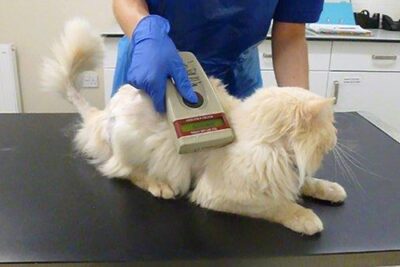Vaccinations and Microchipping
What is a vaccine
A vaccine is a preparation of either killed or modified microorganisms that is administered into the body. Vaccines work by stimulating the body’s immune system to recognize and learn how to fight the microorganism so that if the microorganism is encountered in the future, the dog will either not get sick or will have a less severe illness.
Vaccines are generally administered as a subcutaneous injection (under the skin) but some vaccines such as Kennel Cough vaccine in dogs may be administered locally as a drop into the nose.
When designing a vaccination program, veterinarians consider the pet’s lifestyle, related disease risks, local government veterinary regulation, and the characteristics of available vaccines.
What is a microchip

A microchip is a small electronic chip (rice grain size) inserted/ implanted under your pet’s skin using a special syringe. It is a universal method used to permanently identify your pet. It is normally inserted in the lose skin in between the shoulder blades. Most pets tolerate it and don’t even flinch when it’s happening.
It is important to note that a microchip is not an active tracking device. The chip only contains a unique number which can then be cross referenced with the owners’ details when the chip is inserted and the animal is registered.
The chip is “read” by using a small portable hand-held scanner which is waived over the animal. This picks up the unique number and it means that the owners’ details can then be obtained and contacted.
Vaccine Groups
Here at The Veterinary Hospital, we follow the World Small Animal Veterinary Association (WSAVA) vaccination guidelines and in keeping in line with manufacturer instructions, we recommend the following program:
DOGS
- Core Vaccines for Dogs are Canine Distemper Virus, Canine Adenovirus-2 (Hepatitis), Canine Parvovirus, Canine Parainfluenza, Leptospirosis (DHPPiL) and Rabies virus.
- Non-Core Vaccine for Dogs is Kennel Cough Vaccine.
- First core vaccine at 8 weeks old and not any earlier to avoid clashing with their maternal immunity from their mother.
- Second core vaccine (including Rabies) at 12 weeks old.
- 7-10 days after that, a puppy can be taken out on walks, play dates and mixing with fully vaccinated dogs but to avoid dog parks, day care/ kennels until an antibody titer test is done to determine immunity and protection levels. That way puppies get the socialisation aspect but not the exposure to viruses.
- Third core vaccine at 16 weeks old.
- At 18 weeks old (2 weeks after the last vaccine) VacciCheck (antibody titer test) must be performed. Titer testing is the new gold standard in veterinary medicine.
- From there on, an annual booster is required for all or some of the vaccines, in line with the local veterinary authorities’ regulations.
CATS
- Core Vaccines for Cats are Feline Panleukopenia Virus (Feline Enteritis), Feline Calici and Herpes Virus or Cat Flu (PCH) and Rabies virus.
- Non-Core Vaccine for Cats are Feline Leukaemia Virus and Ringworm which is particularly useful for long hair cats such as Persians and Turkish Angoras…etc.
- First core vaccine at 8-9 weeks old and not any earlier to avoid clashing with their maternal immunity from their mother.
- Second core vaccine (including Rabies) 3-4 weeks later.
- Third core vaccine 3-4 weeks after that.
- Two weeks after the last vaccine, VacciCheck (antibody titer test) must be performed. Titer testing is the new gold standard in veterinary medicine.
- A kitten will not be fully protected until seven to ten days after completing the vaccination program.
- From there on, an annual booster is required for all or some of the vaccines, in line with the local veterinary authorities’ regulations.
Part of the vaccination visit is a thorough clinical examination by our veterinarians, to ensure that pets are in good condition prior to receiving their vaccines and to identify early problems (if present) that may be unfamiliar to the owner.
If your pet is found to be sick, too young, generally underweight or underdeveloped, we will not administer the vaccine and will work with you to correct the presenting problem first.
What to expect after administration of a vaccine
Following vaccine administration, your pet may get some transient discomfort or itching around the site of the injection, but this is usually very short lived.
Other reactions vary from mild fever and lethargy, soreness, loss of appetite especially for cats which tends to resolve by itself within 24-48 hours.
Sometimes a lump may appear at the site of injection as a form of localized reaction. Usually, it is not painful and self-eliminate in few weeks. If it becomes painful or persist more than few weeks, please contact us.
In some small number of pets, a severe allergic reaction (Anaphylactic Shock) may develop which is usually within minutes from receiving the vaccine but maybe delayed for few hours.
If your pet develops the following, please contact us immediately as this is considered a life-threatening emergency:
- Excessive Salivation
- Vomiting
- Diarrhoea
- Hives, Swollen/ Puffy Eyes- Muzzle-Face- Neck
- Coughing or Difficulty Breathing
- Collapse

